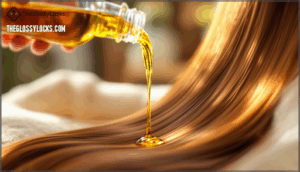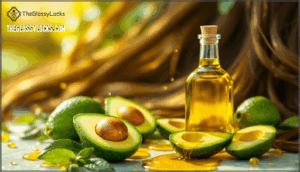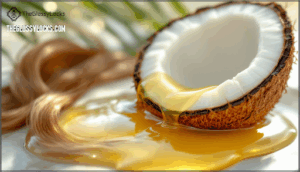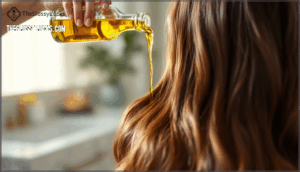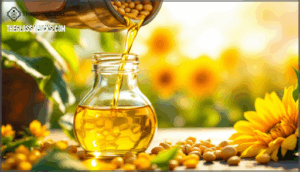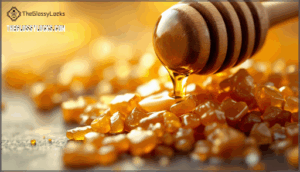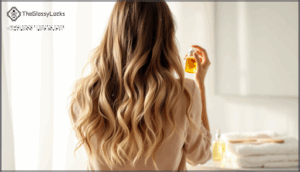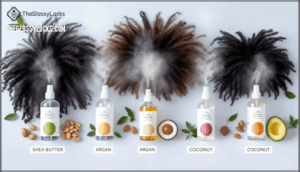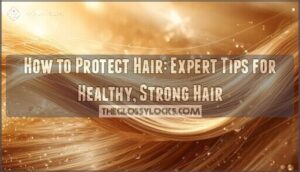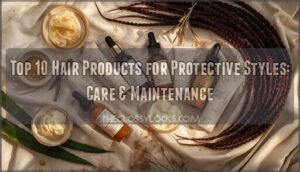This site is supported by our readers. We may earn a commission, at no cost to you, if you purchase through links.
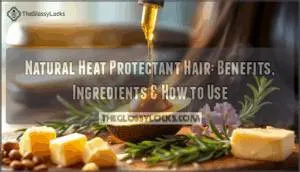
When applied correctly, ingredients like argan and avocado oil can reduce protein loss by up to 50% and cut breakage nearly in half, provided their smoke points align with your styling temperature.
The challenge isn’t whether natural options work, but knowing which ingredients match your hair texture, how to apply them on damp versus dry hair, and when a 350°F smoke point simply won’t cut it for your styling routine.
Table Of Contents
- Key Takeaways
- What is a Natural Heat Protectant?
- Benefits of Natural Heat Protectants
- Best Natural Ingredients for Heat Protection
- How to Use Natural Heat Protectants
- Choosing The Right Natural Protectant for You
- Frequently Asked Questions (FAQs)
- How long does a natural heat protectant last?
- Are natural heat protectants suitable for all hair types?
- How often should I use a natural heat protectant?
- Can natural heat protectants be used on colored hair?
- Are natural heat protectants better than synthetic products?
- Can Natural Heat Protectants Work on All Hair Types?
- How Often Should You Apply Natural Heat Protectants?
- Do Natural Oils Cause Buildup Over Time?
- Can You Use Natural Protectants With Bleached Hair?
- What Temperature Settings Work Best With Natural Protectants?
- Conclusion
Key Takeaways
- Natural heat protectants like argan, avocado, and grapeseed oils can reduce protein loss by up to 50% and cut breakage nearly in half when their smoke points align with your styling temperature.
- The effectiveness of natural oils depends on matching them to your hair texture—fine hair needs lightweight options like diluted coconut oil, while thick or coarse hair can handle richer formulas like shea butter or avocado oil.
- Smoke point matters critically: coconut oil’s 350°F limit restricts styling temperatures, while avocado oil’s 520°F tolerance and shea butter’s 450°F stability work with most heat tools.
- Application technique determines protection quality—oils should be applied to damp hair in sections from mid-lengths to ends, avoiding over-application that creates greasy buildup or gaps that leave strands vulnerable.
What is a Natural Heat Protectant?
Natural heat protectants are plant-based oils and ingredients that shield your hair from thermal damage during styling. They work by forming a protective barrier on the hair shaft, slowing heat penetration and reducing protein loss.
Let’s explore what defines these protectants, how they function at a molecular level, and what sets them apart from their synthetic counterparts.
Definition and Key Functions
A natural heat protectant is a plant-derived oil, butter, or gel that forms a protective barrier on your hair shaft, slowing heat penetration and reducing damage from styling tools like flat irons and blow dryers. These ingredients work by coating individual strands, which helps lock in moisture while creating a buffer against thermal stress.
Key protective functions include:
- Reducing protein loss that weakens hair structure
- Smoothing the cuticle to prevent rough, frizzy texture
- Maintaining hydration during high-temperature styling
- Minimizing color fading from repeated heat exposure
- Preventing breakage at vulnerable mid-lengths and ends
How Natural Protectants Work on Hair
When you apply a natural oil or butter to your hair, its fatty acids penetrate the outer cuticle layer and form a heat-dispersing film. This film slows the rate at which thermal energy reaches the protein core of each strand.
The lipid structure creates a moisture seal, preventing dehydration during styling. Simultaneously, it smooths hair cuticles, reducing friction and mechanical stress.
By slowing heat penetration, these heat protectant ingredients minimize protein loss. This loss would otherwise weaken the hair shaft and lead to breakage.
Differences From Commercial Heat Protectants
Commercial heat protectants rely on synthetic silicones, hydrolyzed proteins, and film-forming polymers that create durable barriers up to 450°F, while natural ingredients lack these engineered compounds.
Here are five key differences:
- Ingredient composition: Silicones like dimethicone versus plant oils with no synthetic additives
- Protection mechanism: True heat-resistant films versus oil-based moisture seals
- Damage prevention: 38–44% water retention in commercial products versus inconsistent natural performance
- Hair suitability: Formulated sprays for all textures versus oils better for thick hair
- Market preferences: Growing demand for nontoxic hair care products drives hybrid formulas combining natural ingredients with proven technology.
Natural options like castor oil can smooth the cuticle and alleviate dryness.
Benefits of Natural Heat Protectants
Natural heat protectants don’t just shield your hair from damage—they actively improve its condition while you style. When you coat each strand with the right oils or ingredients, you’re creating a barrier that changes how heat interacts with your hair’s structure.
Here’s what you gain when you make the switch to natural protection.
Reducing Heat Damage and Breakage
Heat styling doesn’t have to mean accepting damage as the cost of beauty. When you apply natural oils before reaching for your flat iron, you’re creating a buffer that reduces protein loss by up to 50% and cuts hair breakage nearly in half.
Natural oils create a protective buffer that can cut heat damage by half, reducing protein loss up to 50% before you even turn on your flat iron
Long-term benefits include fewer split ends, stronger hair fiber integrity, and better moisture content regulation, all while cuticle crack reduction keeps your strands resilient through repeated styling sessions.
Using heat can lead to increased hair porosity, allowing more moisture to escape.
Enhancing Shine and Softness
Natural oils smooth your hair cuticle like a protective film, reflecting light more evenly while filling in microscopic surface irregularities that cause dullness. The right oil combinations boost your hair’s natural luster, while proper application techniques guarantee you won’t see greasy buildup—just salon-worthy shine.
Why natural oils transform your hair’s appearance:
- Increased light reflection from smoothed cuticles creates mirror-like shine
- Improved hair manageability through better slip and reduced tangling
- Enhanced hair softening as oils penetrate and condition each strand
- Long-term effects include sustained hair hydration between heat styling sessions
Locking in Moisture and Preventing Frizz
Moisture loss from heat styling turns smooth hair into a frizzy halo, but natural oils work as sealants that trap water molecules inside your hair shaft before you even pick up your flat iron or blow dryer.
Your hair porosity determines how effectively cuticle sealing occurs—oils like coconut and argan create a barrier that locks in hair moisture while shielding against humidity effects that usually trigger hair frizz.
Overnight treatments boost hair hydration by allowing natural oils to penetrate deeply before heat styling.
Protecting Hair Color and Health
Your color-treated strands face a double threat—heat tools strip pigment molecules while oxidative stress fades vibrancy, but natural protectants containing antioxidants and lipids form a defensive layer that preserves both the structural integrity and chromatic stability of your hair.
Shea butter and sunflower oil specifically guard against UV protection damage and protein loss, maintaining moisture retention that keeps your scalp health balanced while preventing the accelerated color fading and cumulative hair damage that compromise overall hair health.
Best Natural Ingredients for Heat Protection
Not all natural ingredients stand up equally to the heat of styling tools. The oils and butters you choose matter because each has a specific smoke point, molecular structure, and ability to penetrate or coat your hair shaft.
Below, you’ll find the most effective natural heat protectants, along with what makes each one work.
Argan Oil
Argan oil sits at the top of many cosmetic chemists’ lists for heat protection, thanks to its smoke point of 420°F and rich antioxidant profile that genuinely shields hair from thermal damage.
You can apply it directly to damp hair before styling, or blend it with other carrier oils for enhanced protection across different hair types.
It works particularly well on medium to thick textures, delivering moisture without the heavy residue that weighs down finer strands.
Avocado Oil
Avocado oil brings a smoke point of 520°F to the table, making it one of the most heat-stable natural options you’ll find for protecting hair during high-temperature styling. Beyond heat protection, it shields strands from sun damage and penetrates deeply to nourish coarse or damaged textures.
You can mix it with water for lighter application on fine hair, or blend it with argan oil for enhanced protection across all hair types.
Coconut Oil
Coconut oil is a popular choice, but it comes with a catch—its smoke point of 350°F means you’ll want to keep your flat iron dialed down or risk frying the oil right into your hair. That said, research shows coconut oil reduces protein loss by up to 38% when applied before heat styling, making it a solid protectant for fine or normal hair types.
Here’s how to use it effectively:
- Dilute with water (1:3 ratio) for lighter application
- Apply to damp hair, not dry strands
- Use sparingly—a dime-sized amount goes far
- Keep styling tools below 350°F
- Focus on mid-lengths and ends to avoid greasy roots
Grapeseed Oil
Grapeseed oil sits at a smoke point of 420°F, making it a reliable pick for thick or coarse hair that needs higher heat to cooperate.
It’s lightweight enough not to weigh down strands, yet rich in linoleic acid to nourish your scalp and improve manageability.
You can apply it directly without dilution—just a few drops worked through damp hair gives you solid natural hair protection without the greasy aftermath.
Sunflower Oil
Sunflower oil brings a smoke point of 440°F to the table, along with a lipid structure that actually penetrates the hair fiber instead of just sitting on top. Its conditioning properties help you defend against heat damage up to that temperature.
It works well as a DIY heat protectant when you mix it with water—try a 1:2 dilution ratio before applying to damp strands for solid hair protection without residue.
Shea Butter
Shea butter isn’t technically an oil—it’s a fat extracted from shea tree nuts—but that thicker consistency gives you serious staying power when you’re working with high heat. It melts into your strands, creating a moisture-sealing barrier that won’t evaporate under your flat iron.
Shea Butter Benefits you’ll actually notice:
- Protects hair up to 450°F without smoking or breaking down
- Delivers fatty acids that reinforce weakened cuticles
- Works as a standalone DIY heat protectant or blends with lighter oils
- Provides slip that reduces mechanical damage from combing heated hair
- Conditions without silicone buildup, so moisture can still penetrate
Warm a pea-sized amount between your palms before applying to damp hair—Shea Butter Application gets easier once it liquefies from your body heat.
Aloe Vera Gel
Aloe vera gel takes a completely different approach—instead of coating your hair with oil, it forms a lightweight, water-based shield that won’t weigh down fine or oily hair types. You’ll get hair hydration without the grease, plus scalp soothing properties that calm irritation from frequent heat styling.
Gel application works best on damp hair—mixing aloe with a drop of argan oil gives you balanced protection against heat damage.
| Aloe Benefits | Why It Matters |
|---|---|
| Forms breathable barrier up to 350°F | Protects without suffocating strands |
| Polysaccharides seal cuticle layers | Reduces moisture loss during styling |
| pH-balancing properties | Maintains healthy scalp environment |
| Blends easily with oils | Creates custom DIY heat protectants |
Honey and Propolis
Honey and propolis might seem like an odd pairing for heat protection, but these sticky bee products pack humectant and film-forming compounds that lock moisture inside your hair shaft while creating a flexible thermal barrier.
Propolis protection comes from resins that seal cuticles up to 350°F, while honey benefits include fructose molecules that attract water.
Dilute honey with distilled water before honey application, and test propolis safety on a small section first—some people react to bee-derived ingredients.
How to Use Natural Heat Protectants
Applying natural heat protectants correctly makes the difference between healthy, protected hair and unnecessary damage. The method you choose depends on your hair type, the oil you’re using, and whether dilution is necessary.
Here’s how to get the most protection from natural ingredients while avoiding common pitfalls.
Application Tips for Different Hair Types
Your hair type determines how much oil your strands can take without turning into a slick, greasy mess—or worse, not getting enough protection at all. Fine hair needs lighter oils like grapeseed or diluted coconut oil to avoid weighing it down, while coarse hair and curly hair can tolerate richer formulas like shea butter or avocado oil.
Oily hair benefits from minimal application focused on ends only, whereas dry hair thrives with generous coverage from mid-shaft down to seal in moisture during heat styling.
Diluting and Mixing Oils Safely
Mixing oils with water or combining different carrier oils isn’t just about thinning them out—it’s about controlling viscosity and heat distribution without compromising the protective barrier your hair needs.
For a DIY heat protectant, use a 1:3 oil-to-water ratio for lighter coverage, or blend compatible oils like argan and avocado based on smoke point.
Always patch-test for allergies, store mixtures in dark glass bottles, and avoid combining natural oils for hair protection with ingredients that separate or oxidize quickly.
Step-by-Step Styling Routine
Once you’ve prepped your oil blend and your hair is towel-dried, the real work begins—applying the protectant evenly, controlling your tool’s temperature, and timing each pass to shield every strand without overloading it.
Start with hair prep: divide damp hair into sections using clips, then apply your DIY heat protectant from mid-lengths to ends using a sectioning technique that guarantees coverage.
Set your heat styling tool to appropriate heat settings for your texture, style each section once, then finish with product layering or a light serum for polished finishing touches.
Common Mistakes to Avoid
Even experienced DIYers slip up with natural oils, turning a protective barrier into a greasy film, a smoking mess, or worse—a shield that fails when the flat iron hits. Over-application is the biggest culprit, weighing hair down and attracting more heat damage.
Inconsistent application leaves gaps where hair styling heat penetrates unprotected. Using the wrong product—like low-smoke-point coconut oil at high heat—can burn strands instead of protecting hair from heat damage.
Ignoring ingredients and cranking up your tool past your oil’s thermal limit guarantees hair damage, not defense.
Choosing The Right Natural Protectant for You
Not every natural oil works the same way on every head of hair. Your hair’s thickness, texture, porosity, and styling temperature all influence which ingredients will protect it best.
The following factors will help you select natural heat protectants that match your specific needs and styling routine.
Matching Ingredients to Hair Texture
Fine hair doesn’t respond to the same ingredients as thick, coarse curls, and choosing the wrong oil can leave you with either greasy roots or brittle ends that snap under heat. Here’s how to match natural heat protectants to your hair texture:
- Fine hair: Use lightweight oils like grapeseed or diluted coconut oil that won’t weigh strands down
- Thick hair: Opt for richer ingredients like shea butter or avocado oil that penetrate dense cuticles
- Oily hair: Choose dry-touch options like aloe vera gel; skip heavy oils near roots
- Dry or curly hair: Layer moisture-rich coconut or argan oil to seal hydration before styling
Your hair type determines which ingredients protect without compromising volume or texture.
Smoke Points and Safe Styling Temperatures
The oil you choose needs a smoke point above your styling temperature, or you risk turning your heat protectant into a source of damage. Most heat styling tools operate between 250°F and 350°F, so natural heat protectants like avocado oil (520°F), grapeseed oil (420°F), and shea butter (420°F) stay stable under typical styling conditions.
Coconut oil’s lower smoke point of 350°F makes it suitable only for fine hair styled at moderate heat, while oils that break down below 300°F can release free radicals and acrolein when overheated, causing scalp irritation and weakening your strands instead of protecting them.
Factors for Sensitive Scalps or Colored Hair
If your scalp reacts to everything or you’ve invested in color that you’d rather not watch fade, picking the wrong oil can undo the protection you’re trying to build in.
Scalp sensitivity often stems from ingredient sensitivity or pH balance disruptions, while hair color fades faster when exposed to oils that strip cuticle-sealed dyes.
For gentle application and hair and scalp health, consider:
- Aloe vera gel: calms irritation without clogging follicles, ideal for reactive scalps
- Shea butter: neutral pH protects color-treated hair while conditioning sensitized strands
- Diluted sunflower oil: lightweight protection for delicate hair types without overwhelming the scalp
Natural heat protectants work best when matched to your hair type’s unique vulnerabilities.
Combining Ingredients for Enhanced Protection
Some oils bring one strength to the table, but layering complementary ingredients can multiply the protective barrier your hair gets from heat. Synergistic oil blends, like argan and avocado, combine lightweight penetration with high smoke points for enhanced moisture retention and heat damage prevention.
Individualized hair masks mixing shea butter with aloe vera offer both scalp health boost and damage repair focus. DIY hair care lets you tailor natural ingredients and hair care ingredients to your specific needs, combining natural ingredients strategically for enhanced protection.
Frequently Asked Questions (FAQs)
How long does a natural heat protectant last?
Natural heat protectants don’t build permanent barriers, so reapplication frequency depends on environmental factors and styling habits.
Oil absorption varies by hair porosity, but most oils provide heat damage prevention for one styling session before you’ll need to reapply for continued protection against heat damage.
Are natural heat protectants suitable for all hair types?
Most natural heat protectants work across hair types, but oil weight considerations and porosity levels matter greatly.
Lightweight options suit fine hair better, while thick textures tolerate heavier oils without compromising hair health or causing scalp sensitivity issues.
How often should I use a natural heat protectant?
Each time you heat style, you’ll want to apply a heat protectant—that’s your hair’s best defense against thermal stress.
Daily use won’t harm your strands, but watch for product buildup if you’re styling frequently, which can weigh hair down and affect its condition.
Can natural heat protectants be used on colored hair?
Yes, you can use natural heat protectants on colored hair. Ingredients like argan oil and shea butter provide UV protection and minimize color fade while reducing hair damage during heat styling.
These natural options support ingredient compatibility and hair health without harsh chemicals, offering long-term effects through proper application techniques.
Are natural heat protectants better than synthetic products?
Think of it like comparing a handmade shield to a factory-forged one—both defend, but with different trade-offs. Natural heat protectants offer fewer synthetic ingredient concerns and environmental impact advantages, though the natural efficacy debate continues since commercial products often provide enhanced heat damage protection through specialized ingredients engineered specifically for hair health.
Can Natural Heat Protectants Work on All Hair Types?
Most hair types can benefit from natural heat protectants, but texture compatibility and hair porosity matter. Fine hair responds well to lightweight oils that won’t cause product buildup, while thicker textures tolerate heavier formulations.
Oil absorption rates vary, and scalp sensitivity requires careful ingredient selection for best hair protection during heat styling.
How Often Should You Apply Natural Heat Protectants?
You’d think something called a "protectant" would need constant reapplication, but natural heat protectants only need to be applied each time you use heat styling tools.
Product buildup, hair porosity, and environmental factors influence how well they perform between washes, though overnight protection isn’t necessary.
Do Natural Oils Cause Buildup Over Time?
If you’re using the same heat protectant oils daily without proper cleansing, residue can accumulate on the hair shaft, eventually clogging scalp pores and weighing hair down.
Balancing product application frequency with clarifying shampoos helps maintain hair health and prevents buildup.
Can You Use Natural Protectants With Bleached Hair?
You can absolutely use natural heat protectants on bleached hair—in fact, they’re essential for porosity considerations and bleach damage repair.
Prioritize protein balance with lightweight oils like grapeseed or sunflower to prevent product buildup while supporting color retention and minimizing heat damage and hair breakage.
What Temperature Settings Work Best With Natural Protectants?
Heat styling tools can reach 450°F or higher—way beyond what most natural heat protectants can manage safely. You’ll need to match your temperature settings to the oil smoke points you’re using. For coconut oil’s 350°F limit, keep tools below that threshold.
Fine hair tolerates 250-300°F, while thick or coarse hair types need 350-400°F for effective heat distribution. Temperature monitoring prevents heat damage when protecting hair from heat damage with natural heat protectant options.
Conclusion
Your next blowout or flat iron session won’t have to mean choosing between heat styling and hair health. Natural heat protectant hair options—argan, avocado, grapeseed, and others—deliver measurable protection when their smoke points match your tools and their application suits your texture.
Start with a single oil you trust, apply it sparingly on damp strands, and watch how your hair responds. If breakage drops and shine returns, you’ve found your formula. The real test isn’t being completely without fault on day one; it’s consistency over weeks, adjusting as you go.
- https://pubmed.ncbi.nlm.nih.gov/12715094/
- https://www.k18hair.com/blogs/consumer/the-science-of-heat-protection-by-oil
- https://pmc.ncbi.nlm.nih.gov/articles/PMC6823552/
- https://www.nexxus.com/us/en/haircare-101/science-why-need-to-use-heat-protectant-spray-after-wash.html
- https://www.curlynikki.com/heat-protectants-silicones-are-our.html


